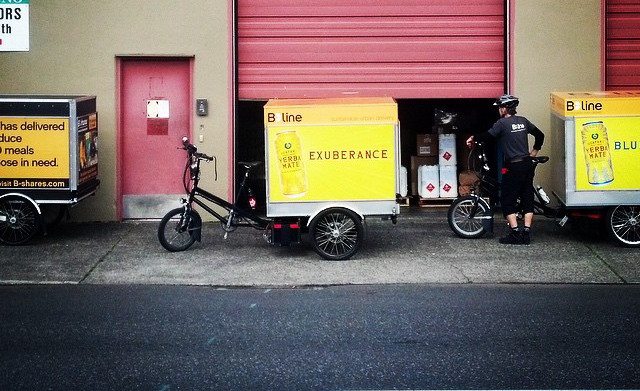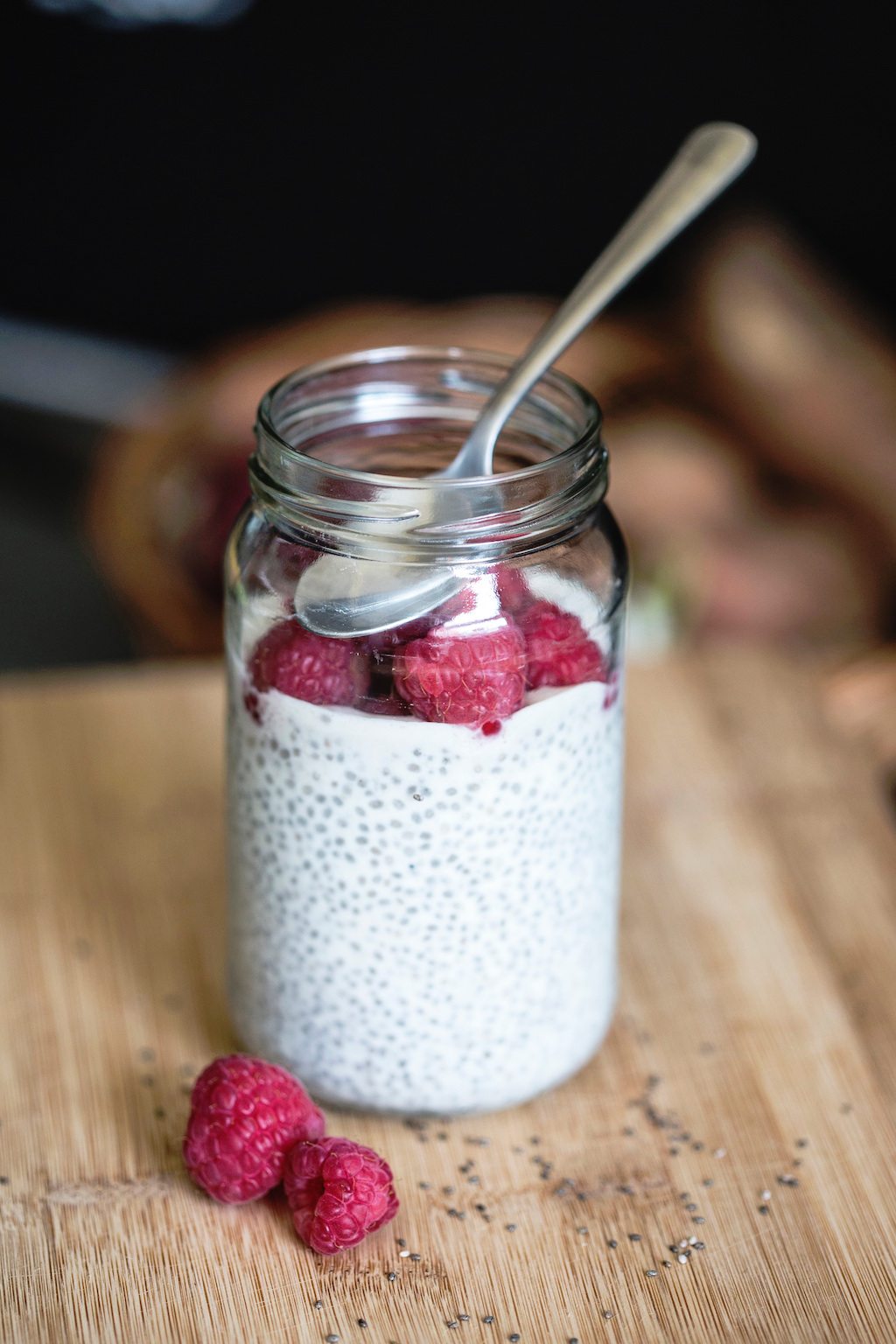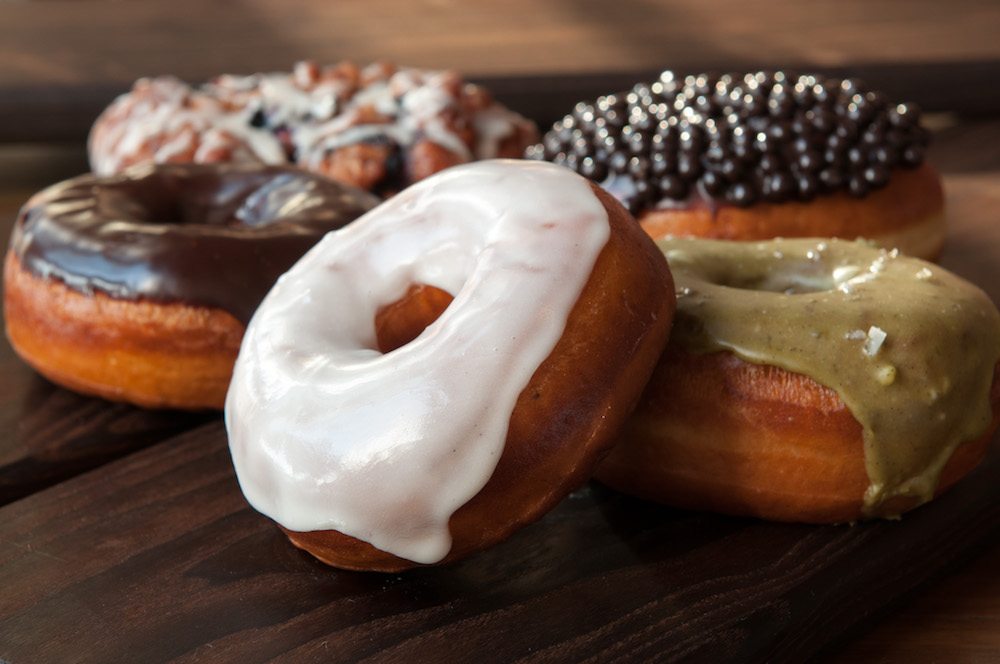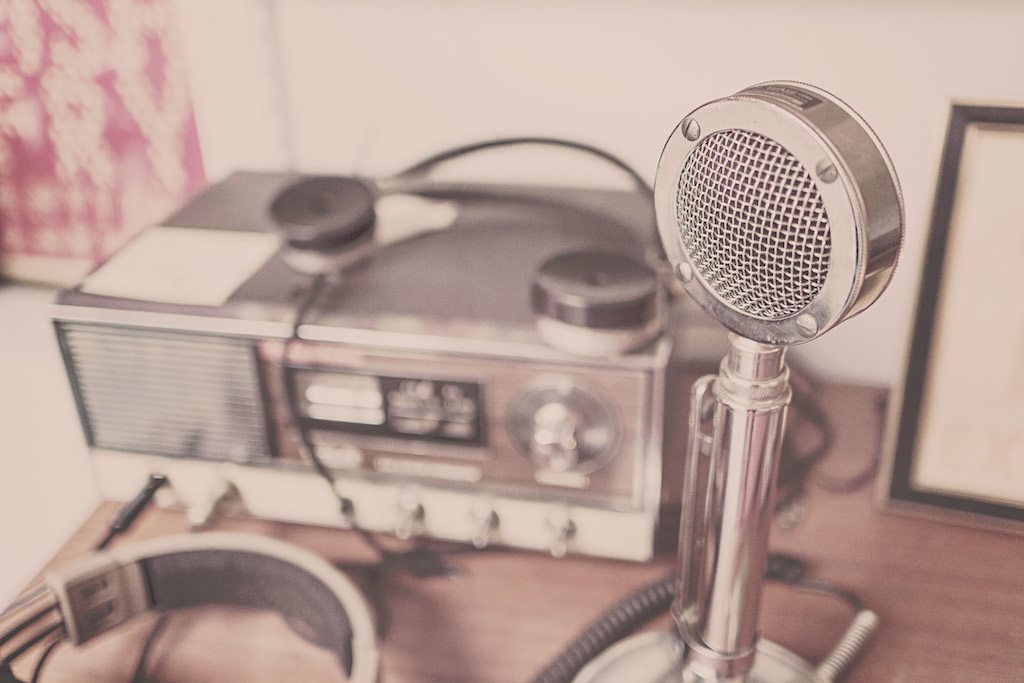
The cargo trike: emission-free, human-scaled, picturesque. It might sound like a carbon-neutral fantasy that could never compete with an 18-wheeler. But there’s actually reason to believe we can replace trucks with trikes–at least in cities.
Trikes are nimbler than vans. They can park on the sidewalk, ride in bike lanes, and navigate tight spaces. They may be slow, topping out at about eleven miles per hour, but one 2014 study, conducted by the University Transportation Research Center, found that in congested urban areas trikes can actually travel faster than vans or trucks. A recent study in Europe estimated that in cities, trikes could realistically replace up to half of the hauling operations on the road.
Cargo trike delivery is slowly catching on. The 2014 study identified 12 U.S. and Canadian companies offering cargo trike delivery services, mostly of food. The city of Cambridge, Massachusetts hired Metro Pedal Power to shuttle recyclables from public bins to local recycling plants. Big companies like DHL and U-Haul are piloting three-wheeled delivery in Europe.
https://www.instagram.com/p/s3SH4UhAu6/?taken-by=dhlthailand
So are we on the brink of a three-wheeled takeover? Can trikes generate enough dollars to survive in the competitive last mile logistics marketplace? The jury is out. To understand why, take a look at the story of B-Line Sustainable Urban Delivery, a seven-year-old trike-based delivery service in (where else?) Portland, Oregon. What started as a two-bike, two-person, two-customer endeavor has grown to a 15-person company delivering to over 200 locations in downtown Portland, traveling almost 100,000 miles since 2009, and hauling 512 tons of organic produce in 2014. With a deal inked to manage logistics for a massive soon-to-open food hub, the company is poised to have a broad-reaching impact on the way the city’s food gets from farm to fork.
 CycleLogistics
CycleLogistics This CycleLogistics study in Europe concluded half of all truck and van deliveries could be replaced with bicycles and tricycles
B-Line’s founder, Franklin Jones, was a bicycle guy from an early age—a competitive cyclist from Kentucky who planned bike paths for the city of Bend, Oregon after college. He worked for a while as a teacher in Japan, then took a 13-month, 11,000-mile cycle trip from Tokyo to Ireland.
“I saw bikes carrying goods and providing services,” Jones told the New York Times in 2013, “from the typical loaded-down rickshaw on the streets of India to a more modern bike in Europe carrying bread or delivering the mail.”
“It just wasn’t practical to stop our trucks at these places.”
He decided to try launching his own delivery service, and Portland proved to be a savvy choice. B-Line benefits from the city’s relatively lax regulations on bicycles with electric assist motors, the kind Jones uses. (Similar models in other U.S. cities have hit roadblocks as delivery companies negotiate with municipalities—e-bikes are still technically illegal in New York, for instance, and food safety concerns have plagued other efforts.) He bid on a job with Portland Roasting Coffee, got it, and was on his way.
Tricycle delivery is a bit like a three-legged race. It’s a game of limitations. B-Line’s trikes have a capacity of 600 pounds or 60 cubic feet. That’s about one-fourth the volume and one-sixth the weight a nine-foot cargo van can haul. Limited capacity comes with its downsides, but it’s also kind of the whole point—trikes can make small deliveries without wasting energy. Glen Dahl, a B-Line customer and co-founder of Dave’s Killer Bread, says in a B-Line promotional video that prior to using trike delivery, he was losing customers who couldn’t order at a high volume. “Very deserving customers that we really appreciate having—let’s face it—it just wasn’t practical to stop our trucks at these places.”
https://www.instagram.com/p/BFsC338B7xO/?taken-by=blinedelivers
On the other hand, trike delivery services are limited by how far their riders can travel in a day (10 to 20 miles) and how much their trikes can carry at a given time. Though the vehicles are cheaper to buy and maintain than their four-wheeled counterparts, trike outfits need warehouse space located in or near city centers, where real estate is more expensive. And then there are the regulations: some states require workers comp insurance for riders, for instance.
Trikes also lack the economies of scale that put trucks on the road in the first place. The 2014 study, which was commissioned to determine feasibility for New York City, points out that it’s not as simple as replacing vans with trikes at a one-to-one ratio—a full van with an optimized route would take several tricycles to perform the same task, quickly pushing operating costs through the roof. Increased operating costs translate into higher delivery fees and/or lower profit margins. In the Times piece, one of B-Line’s customers admitted that the trike service is a little more expensive per delivery than a van or a truck, though a City of Portland case study calls it cost-neutral.
B-Line rider standing next to a trike advertising B-Shares, a program that delivers extra food from retailers to food pantries
Given the limitations of trikes, the goal is straightforward: keep the box as full as you can for as much of the day as possible, and try to maximize revenue per mile.
To compensate for those limitations, Jones started looking for extra things to haul that coordinated well with the core business. He arranged for his drivers to collect surplus food from restaurants, farmers’ markets, and grocery stores along their existing routes, then deliver the goods to food pantries, funded at least in part by individual donations. It wasn’t a perfect circular pattern, but it meant that the trikes were not coming home empty from their deliveries.
Then there’s the billboard factor. Any company that delivers the goods on three wheels gets automatic style points for sustainability, and there’s an added halo effect (even if all the trike carries is a corporate logo splashed on the side of the trike). Jones realizes this, and B-Line offers mobile ad space and promotions. The company’s advertising arm is expanding— team members recently biked a set of IKEA furniture to the top of Portland’s Marquam Bridge to build “a room with a view,” and B-Line partners each year with yerba mate company Guayaki to help launch new products. B-Line’s job listings currently include “brand ambassador,” a position that asks applicants to be “open to an entrepreneurial environment.”
Advertising space is available on the sides of the trikes
Beyond ad sales, B-Line wants to expand its distribution arm. “This is your new nutrition bar, your hot sauce, your pasta, your granola—companies that have gotten past the recipe stage, are into their co-packers, but are not into a mainline or a broad-line distributor,” says Jones. Rather than hand-delivering their goods to several different stores, small business owners can drop off once at B-Line and save time.
But further expansion will take more farmers and manufacturers and, crucially, more warehouse space. To that end, the company has signed on as anchor tenant in The Redd, a new food hub spanning two downtown blocks in Portland. “It’s less of a retail food hub and more of a warehousing, logistics, and production food hub,” Jones says. The Redd will provide essential services to midsize farmers, ranchers, and food business owners who have outgrown direct-to-consumer channels like farmers’ markets. Slated to open in spring of 2017, the space will be a sort of one-stop shop for food businesses from the surrounding area. With cold and room temperature storage in addition to packaging space, tenants will be able to package and store their products for final delivery—and they’ll have a built-in last mile logistics provider.
As anchor tenant, B-Line will manage all the warehousing, aggregation, and last-mile logistics operations in the 20,000-foot space. They’ll be headquartered within a growing community of potential customers, and that proximity will make them an even more integral part of the path between farm and fork.
That additional warehouse space could also help B-Line expand a program that currently makes up a tiny portion of their business—backhauling recyclables. In order to keep the trikes as full as possible, B-Line’s cyclists are picking up tough-to-recycle items like styrofoam and hard plastics for customers, saving them trips to the dump. A trike on a grocery store route might arrive carrying peanut butter and leave carrying packing peanuts, generating some revenue in both directions.
The income generated from backhauling, however, is also peanuts. Jones estimates his current flat-rate service brings in $1,500 a month, but it’s recycling materials that would likely be headed for the trash otherwise. And it’s functioning at a low volume—for instance, a typical pickup could include a trash bag full of plastic bottles from under a desk at a law office.
But Jones hopes to expand into mainstream recyclables by backhauling materials he could actually sell. The way he explains it, mainstream recyclables actually generate a profit for vertically integrated businesses like Kroger and Duane Reade. Those companies carry materials like cardboard to their regional hubs, bundle them into units, and sell them to paper mills (cardboard) or ship them to China (plastics). They own the hubs, the means of transportation, and the bundling equipment. Smaller chains and independent businesses in Portland, on the other hand, have to pay waste haulers to manage their recycling. Jones would like to turn part of the B-Line warehouse space in the Redd Building into a bundling facility, selling pallets of sorted recyclables to regional mills and beyond.
https://www.instagram.com/p/8GfwjvB7_f/?taken-by=blinedelivers
On paper, it’s a win-win. Portland’s recycling and garbage is on an open competitive system, meaning 20-plus companies compete to haul waste to regional hubs for processing. If B-Line took over recycling for a local market (New Seasons, for instance, which it’s been in talks to do), it could aggregate and bundle cardboard in The Redd and sell it to regional mills.
A full-service, one-stop product delivery and recycling pickup could have broad appeal. But with build-out costs and uncertain demand, a program like that would have to operate on razor-thin margins, and a dive in oil prices would be enough render it unfeasible. Jones cites the current rock-bottom prices of commodities as enough of an obstacle to take conversations with New Seasons off the table. And businesses in Portland generally contract with one waste management company to manage garbage and recycling, so the program may not be as easy to sell as it sounds.
It’s unlikely that B-Line will completely revolutionize the way local foods are distributed, redistributed, and disposed of in Portland. But as a cargo trike company facing a considerable uphill, albeit electric-assisted, battle, incorporating a backhauling operation might provide the extra push it needs to stay on the road.
We’ve got a long way to go before trikes replace half of all trucks and vans in city traffic. It’s a tough business to break into. There’s not much uniformity across the country in policies or even bike lane construction. And profit-wise, trike delivery is not an obvious ace in the hole. But B-Line’s incremental advances are an encouraging starting point. Let’s say they’re…paving the way.












